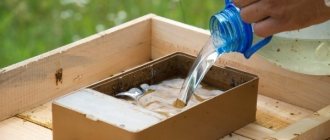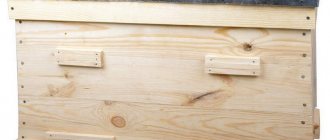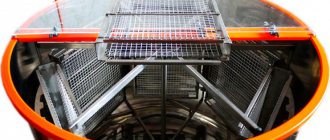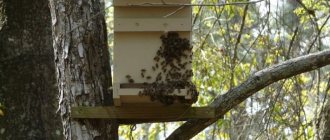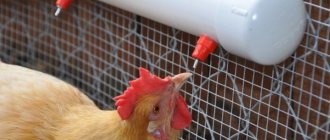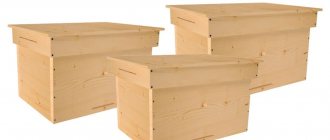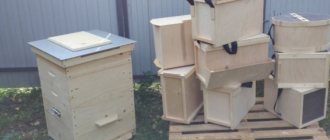Types of pavilions
- The mobile pavilion , moreover, has mobility - it can easily be moved to flowering areas of nectar collectors at the desired period. Most often, such a mobile pavilion is made by hand in trailers or truck vans, adjusting the design drawings to its size.
- A stationary pavilion for bees is not so mobile , it is not placed on wheels, and is most often installed for a long time in a specific apiary. Its purpose is to save apiary space and make it easier to maintain bee colonies.
- Mobile cassette pavilions are especially popular among beekeepers . When constructing a pavilion with your own hands, it is necessary to take into account the main parametric features of the vehicle that will serve as a tractor for the structure. The cassette pavilion must “fit” into the van in such a way that there is easy access to all hives, and that there is a workplace for the beekeeper, a small closet for work.
- A cassette pavilion is a structure similar to a chest of drawers - each hive is located in a separate cabinet, which is independent from the others. Keeping bees is simplified - it is easier for the beekeeper to carry out anti-varroa measures if there is no brood, even late in the fall. In addition, this design for bees can be easily moved to the territory of honey plants. Moreover, the beekeeper can do this alone - and he will not need either a smoker or a face mask. With the usual keeping of bees in hives, moving them is always a long and labor-intensive process.
Insulation
For comfortable wintering of bees, it is necessary to take care of insulating their home. The insulation is laid between plywood walls. It is convenient to use foam or mineral wool as insulation. The cracks are foamed with polyurethane foam, or sealed with tape with insulation padding, so that all compartments will be warm.
In the summer, double walls will save you from overheating.
If you nevertheless decide to build a pavilion with your own hands, then it is better to complete its construction before the first spring inspection. Let it sit a little and air out. Bees do not like foreign odors (paint, polyurethane foam, etc.). And when you remove the hives, immediately move the bees to the pavilion.
Features and methods of keeping bees in hives
Pavilion for keeping bees: how effective is it?
Keeping insects in cassette-type pavilions has many advantages. The main ones include:
- Easy to maintain and keep insects.
- Increase in honey yield by one and a half to two times.
- Creating optimal conditions for safe wintering of bees.
- Maintaining the desired temperature regime and reliable protection from adverse weather conditions, which ensures the strengthening and development of bee colonies.
- Possibility of using the pavilion as a mobile apiary.
- Durability and reliability of the design.
Necessary materials
In the construction of bee pavilions, a standard set of materials is used. To make a metal frame, you will need cutting equipment and a welding machine, plumbing and carpentry tools. In addition you will need:
- boards;
- plywood;
- several sheets of fiberboard or chipboard;
- polystyrene foam as insulation;
- fine mesh (nylon or metal - it doesn’t matter);
- roofing iron or roofing felt;
- Nails, screws, and fasteners are required for assembly.
Design idea
Mobile and stationary pavilions for bee families will help save space in the apiary. In addition, with their help you can make wintering and keeping bees easier, as well as significantly increase the percentage of yield. You can build it yourself, but you will need special drawings. The mobile pavilion is mobile, so it can be easily moved to suitable locations, such as flowering centers at specific times. When designing, you can use vans or truck trailers, drawing up a drawing of the device according to the appropriate size.
As for the stationary pavilion for bees, it does not have high mobility. It is not put on wheels. It is installed at a specific location in the apiary for a long period of time. The main purpose of the device is to facilitate the wintering and maintenance of bees, as well as to save space.
In beekeeping, there is a rule that implies that all bees must be completely safe, especially during the winter. Cassette pavilions are extremely popular. You can make them yourself. When constructing them, it is important to take into account the main features of the parameters of the automotive equipment acting as the tractor of the device. A self-made cassette pavilion for bees must fit into a van or trailer so that there is free space for the beekeeper to work (a small cubby).
The cassette bee pavilion resembles a kind of chest of drawers, in which hives with bees are located in separate cabinets, independent of each other. Thus, the process of keeping and wintering bees is simplified, and it is easy for the beekeeper to carry out all the necessary activities. The cassette structure can be easily moved to a specific area with honey plants. The beekeeper can do this manipulation independently, without using a face mask or a smoker.
Types of bee pavilions
Bee pavilions come in two types: stationary and cassette.
The stationary bee pavilion does not provide for moments of movement. It is a solid structure made of metal panels, with evidence rooms made of plywood. This beehouse has a utility room in which the beekeeper stores his working equipment. It is possible to reconstruct a stationary pavilion into a mobile one, but in this case you should select wheels. Another disadvantage of converting a stationary beehouse into a mobile one is that it will be too heavy and inconvenient.
On a note! The mobile version of the bee house is practically no different from the stationary one in terms of the floor plan. The same utility room for storing equipment, the same location of evidence along two walls. What distinguishes a mobile pavilion from a stationary structure is the presence of a wheel pair in the first, with the help of which the structure can be moved from place to place.
Differences between houses for insects
Stationary and cassette types of bee pavilions still differ from each other; before constructing a pavilion with your own hands in your apiary, you should give preference to one type.
These two types of insect houses are undeniably good. Their main differences end in the availability of one wheel pair option. They save space in the apiary, their presence calms the beekeeper in the winter, since the bees are kept warm, life in the bee pavilion increases honey production by 30%. In them you can divide the bees into brood and broodless ones and place them on both sides of the aisle.
Honey from bees' honeycomb
Recently, beekeepers have given greater preference to the mobile variety of bee houses. Because of its transportability, the cassette type is more profitable to maintain. A stationary view can be reconstructed into a mobile view, but it will cost several times more than creating a pavilion with your own hands. The cassette house for honey insects is easy to use and maintain. It can be transported closer to the flower stalks; it is more convenient to treat walls and floors against bee diseases such as nosematosis.
Thus, it becomes clear that it is not so difficult to build a house for honey insects with your own hands. This is a very advantageous design in terms of caring for bees and collecting honey.
What are the benefits of cassette beekeeping?
Over several decades, a friend of mine has tested almost all types and systems of hives and came to the conclusion that cassette beekeeping is very convenient and profitable. And it was like this...
Closer to the mid-80s of the last century, he built himself a mobile pavilion, designed for multi-hull hives, designed to keep bees all year round. However, the working conditions in the pavilion turned out to be not entirely convenient, and to be more precise, completely uncomfortable. After all, to inspect the lower building, he had to move all the upper buildings to the floor, and after finishing the work he had to do it all in reverse order. This took a lot of time and effort. In addition, inconvenience was caused to the bees.
Towards the end of the 80s, an acquaintance of mine saw a cassette hive in Moscow. He really liked this hive and by the end of 1990 he had completely remodeled his pavilion for cassette hives and started cassette beekeeping, so to speak.
On the side walls he placed stationary cassette compartments of the hives according to the principle of a chest of drawers. In each of the compartments he placed six retractable cassettes, independent of each other, vertically. Each cassette was designed for 10 frames with dimensions of 435x230. The convenience here is that each cassette can be pulled out for inspection without disturbing the bees in the other cassettes.
At the end of the work, the cassette is simply pushed into place. Agree that this is very convenient. Cassette beekeeping significantly reduces and facilitates the work of the beekeeper, and also minimizes unnecessary disturbance to the bees. Using a cassette system of hive compartments in the pavilion, you can keep bees using any technology.
Advantages and disadvantages
Advantages
Positive qualities of both types of construction:
- take up little space;
- it’s easy to insulate all hives at once;
- there is an opportunity to work in any weather;
- you can treat all the houses and relocate the bee colony if necessary;
- there is free access to any insect home from inside and outside;
- quick collection of honey from all filled frames and stores;
- separate rooms for bees are small-sized and light.
Pavilions, in addition to collecting honey, have other additional functions: they are often used for obtaining and storing queen jelly, pollination and creating layering.
- Good mobility of the mobile pavilion during migration.
- Easy to maintain. During the move, hives constantly need to be loaded and unloaded from the car trailer. It is enough to transport the pavilion to another location.
- The pavilion always maintains optimal conditions for hatching the uterus. There is no such possibility in hives. The process will depend on weather conditions.
- The presence of a mobile house helps to increase honey collection.
- An optimal microclimate for bees is created inside the pavilion. Insects overwinter and develop better.
- Bee families living in one large pavilion create less danger to humans and animals than insects whose hives are scattered over a large area.
Stationary and mobile pavilions are primarily compact. In a small area you can support a large number of bee colonies.
Disadvantages of both types
| Regular option | Mobile design |
| To install the structure you need a foundation | You need a trailer to place the structure in it |
| To fly to remote areas and collect nectar, insects need to expend a lot of effort. To restore them, many individuals eat part of the prey on their way home. | Fuel costs are required to move the pavilion to another location. |
| If a beekeeper spends the whole summer at a mobile apiary, he needs to stock up on food or travel to the nearest town for food and other necessary goods | |
| Due to the proximity of the location, bees may confuse the houses | |
| Some bees can parasitize on fellow bees from other families: they will steal honey from neighboring hives | |
| The structures are fire hazards. They consist of wood, foam or other flammable materials. If the pavilion catches fire, all the bees will not be saved | |
One of the beekeeping technologies
Each beekeeper uses his own technology, which is most convenient for him.
A friend of mine liked the technology he developed himself.
He divides bee colonies into two parts: one of them is brood, the second is sterile.
This technology facilitates the creation of families of honey bees with annual replacement of queens, without wasting time searching for them in a huge mass of bees.
Anti-swarming measures, 100% anti-varroa treatment of bees, as well as mite control also do not take much time. During the entire period, from early spring to late autumn, all of the above procedures take a minimum of time.
The pavilion is very convenient because even in late autumn, in the absence of brood, it is possible to carry out complete anti-varroa heat treatment of all bee colonies at the same time, and this can be done directly in the hive compartments. This procedure will not be particularly difficult. If there is no need to treat all bee colonies, you can get by with treating individual hive compartments, the mite infestation of which exceeds the permissible norm.
Cassette beekeeping is especially convenient in cases where you have to frequently move from place to place. When using a cassette pavilion, the beekeeper does not need to load, unload the hives and arrange them upon arrival at the honey plants.
One beekeeper can easily handle the preparations for the move in any weather. In this case, there is no need to use a smoker and a face mesh.
Upon arrival at the site, it will be enough to install the pavilion on a horizontal platform and open the entrance. This is all that is needed to prepare the bees for honey collection in a new place. I would also like to note that at the end of the honey harvest, my friend takes honey from bee colonies, practically without using a face net.
The use of both mobile and stationary pavilions allows the beekeeper to avoid moving hives to the winter hut in the fall and removing and placing them in the spring. If desired, constant heating of the hive compartments can be provided inside the pavilion.
Stationary
The appearance of the stationary pavilion resembles a wooden utility block. The house is installed on a strip or column foundation. A stationary pavilion has several advantages over its mobile counterpart:
- lighting, water supply, sewerage can be installed in the house;
- For heating in winter, heating is supplied to the pavilion.
In fact, a stationary house is a full-fledged residential complex for bees. The supply of communications facilitates the process of servicing the apiary. Heating makes wintering safe. The bees do not weaken, and the stronger bees begin to work more intensively in the spring.
Stationary pavilions are convenient for wintering bees even without heating. There is enough natural heat inside the house. They try to place a permanent building on the site so that the long side wall faces southwest or southeast.
The roof for a stationary structure is made of two types. A less successful option is considered to be a gable one without opening hatches. Windows are provided on the walls, but in order to open them, free space must be left for access. The best option is a flat roof with opening hatches. Space is saved inside such a building, since cassettes with bees can be placed close to the wall.
When keeping bees in a stationary pavilion, the beekeeper does not need to move the hives to other points or rearrange the houses during inspection. The fixed pavilion consists of a supporting structure, which is constructed of steel, hives and a storage room, in which the beekeeper stores the materials and tools he needs. Such a structure can be converted into a mobile one if necessary.
Features of bee pavilion care
Depending on whether “Berendey” is used as a stationary or mobile structure, caring for the bee pavilion has some peculiarities, although in general the rules for handling the structure and its inhabitants are standard.
By installing a bee pavilion on your site for permanent use, you can get a reliable, strong and well-protected apiary that takes up minimal space and is very easy to use. For nomadic beekeeping, in addition to the pavilion itself, it is also necessary to have a vehicle of suitable carrying capacity, but in this case the honey collection period can be extended almost throughout the summer and, in addition, different types of honey can be obtained.
Important! The only inconvenience that distinguishes working in a bee pavilion from a conventional apiary with many free-standing hives is that all actions have to be performed in a very limited space. The rest of the care is standard and consists of:
The rest of the care is standard and consists of:
- conducting a thorough spring inspection of families in order to inspect their condition and number;
- regular sanitization of cassettes, racks and all equipment used in work;
- feeding insects as needed and constantly monitoring the state of food supplies;
- formation of layering (for this, brood intended for placement in the second tier is used);
- swarming control;
- timely replacement of cassettes, expansion of nests due to new frames and compartments;
- regular pumping of honey;
- ensuring constant cleanliness inside the pavilion;
- feeding insects for the winter and insulating the pavilion for the winter with protective shields.
Mobile
This type of pavilion resembles a trailer. There is a beekeeper's pantry and beehives on it. It is recommended to arrange the beekeeper’s room in such a way that it has a passageway - this way the beekeeper will have easy access to the houses.
The main structure of a mobile pavilion is no different from a stationary bee house. The same wooden building with a flat or gable roof. The main difference is the lower part. If a foundation is poured for a stationary house, then the mobile structure is placed on a chassis.
Usually the chassis is a trailer of a truck or agricultural equipment. During construction, it is jacked up and placed horizontally on supports. The sides of the trailer are removed, leaving only the frame. It will serve as a foundation. The metal frame of the future house is welded to the size of the frame. Sheathing is done with chipboard, boards or other material.
For stationary use, the building can stand on supports. At the beginning of the season, the structure is raised with jacks. The supports are removed from under the trailer. The pavilion with the bees is hooked to the car and taken out to the field closer to the honey plants.
https://youtu.be/zgGUx2lMQ3Q
The cassette mobile design has many advantages:
- Increasing the harvest due to the access of the apiary directly to the seasonal flowering honey plants. Honey yield doubles. Overcoming a shorter distance, the bees bring 100% of the collected product to the honeycombs.
- The beekeeper is given the opportunity to obtain pure honey from one variety of honey plant. Bees will only carry the product from flowers growing nearby. During the season, with frequent moves, you can get several varieties of pure honey, for example: acacia, sunflower, buckwheat.
- The ease of maintenance of a mobile pavilion is the same as that of a stationary structure. The bees remain in their houses for the winter.
The only disadvantage of the mobile pavilion can be considered the impossibility of supplying communications. However, plumbing and sewerage are not so important for bees. Elements of comfort are in demand by beekeepers. As for lighting and heating, wiring is needed. During the winter, the house stands in the yard. The cable is connected to the home electrical network. Light appears inside the pavilion. Heating for bees is provided by electric heaters.
A spoon of tar
There are also disadvantages to using this method. Cassette beekeeping requires certain skills, as well as the construction of a fairly spacious and reliable “house” for bees. Over time, even the strongest structure needs to replace some elements. If inspections and repairs are not carried out, fungus may develop in the cracks of the walls and floors, and the ceiling will begin to leak.
Mice that have taken a liking to the premises can also pose a threat to insects. Bees categorically do not accept such a neighborhood and can leave the hive even from the slightest smell of these pests.
In addition, the cassette pavilion for bees must be equipped with a good ventilation system, otherwise the microclimate in the room may be unfavorable for breeding insects. By following simple rules for maintaining such a structure, you can achieve really good results.
Cassette keeping of bees is very justified even with a stationary location of the structure. Further information in our article will tell you how to make such a pavilion yourself.
Where to start construction
At the first stages of building a bee pavilion, you will need to assemble the frame of the room and divide it into the required number of sections corresponding to the number of bee colonies. Then the pavilion is sheathed, all its parts are assembled into a single structure and roofing work is carried out.
Heating methods for hives
At the final stage, the pavilion is painted with multi-colored oil paint - different colors are necessary so that the bees can navigate in space and do not wander among other pavilions.
The design of the bee pavilion allows the use of windows or hatches - they will serve as additional sources of lighting. As a source of artificial light, you can use lanterns, solar panels, or connect to the electrical network.
Construction work to build the pavilion will take you at least 3-4 months. This is provided that you will not be distracted by other matters. To build a structure, you must first make a drawing on which everything will be marked down to the smallest detail. This will make the work much easier later.
Note! To ensure that bee families do not interfere with each other, it is recommended to construct a pavilion for no more than 25 families.
The beehouse plan has some requirements for the appearance and internal contents:
- The dimensions of the structure should be correctly calculated;
- The bee house must be equipped with both working premises and premises for household needs;
- The drawing must include a ventilation system;
- It is recommended to consider lighting for the beehouse and its heating during the cold season;
- It is imperative to allocate a place in which work equipment will be stored.
You will also need the material from which the bee pavilion will be created:
- Tools for working with metal (cutting, welding, etc.);
- Jack for raising the van;
- Metal corners and channels;
- Wood beams, boards;
- Material for covering the roof of the structure;
- Nails;
- Plywood.
You can construct a pavilion designed for bees with your own hands. First you need to select competent drawings and mini-schemes (shown below) that will meet all construction conditions:
- optimal trailer or van size;
- internal heating function;
- presence of living and working compartments;
- mandatory lighting of the passage located between the change house and the hive with bees;
- the presence of a folding platform and ladders;
- the main condition is ventilation, since without it unwanted dampness and mold will appear;
- luggage compartment - a kind of tier above the hives where the bees are located, as well as under the bottom of the device, they can be used to store all the necessary things and equipment;
- thermal insulation for walls and roofs, which can be constructed using a layer of various insulation materials.
Design idea
Pavilions for bees, both mobile and stationary, help not only save time and space in the apiary, but also increase productivity, simplify preparation for wintering and make it easier to keep bees in the apiary.
Mobile pavilion in a truck trailer
Safety precautions
- The mobile pavilion must have a braking system.
- During construction, all safety regulations must be observed.
- Among the materials for construction there are highly flammable ones. A fire extinguisher is required.
When organizing a nomadic apiary (what else can you call a moving platform with bees?) there are many points that need to be taken into account. To increase the useful space in the trailer, you can install columns with bee colonies in 2 tiers. For ease of movement, the change house is often made through.
Large bee pavilions (for 48 families or more) are difficult to transport on bad roads. Because of this, it may be impossible to deliver them to particularly “tasty” areas. For this purpose, it is better to use compact trailers for 12 families.
This will not happen with stationary pavilions. They are worth it and worth it. They don't go anywhere.
When choosing bees, you should give preference to local breeds; in Russia, Karpatka Carpathian and black mountain bees work well.
Drawings of a mobile pavilion for 14 bee families
The number of sections must correspond to the parameters of the pavilion. Skilled beekeepers advise using no more than 20 sections, otherwise the bees will constantly interfere with each other. First you need to assemble the body to divide it into the number of sections. They are allocated for placing frames according to construction plans. Then all the elements are assembled into a single device, covered with a roof. To do this, you will need certain experience and skill in working with various raw materials, namely metal, wood and other materials.
If the device for bees will be placed in a van, then 3 tiers of hives should be mounted on 2 sides, leaving a passage between them for the beekeeper. For convenience, hatches or windows can be placed above the working passage to provide natural light. To obtain artificial light, you can use a solar panel, batteries and transformers. However, many beekeepers use simple flashlights.
Wintering plays an important role in beekeeping, since the future harvest and the condition of bee families depend on it. In order for wintering to be successful, it is necessary to pay special attention to the insulation of the structure. You can install a layer using conventional construction insulation. If desired, you can use sheets of roofing felt, placing them above the floor and between the plywood ones. For a warmer winter in beekeeping, the front door is insulated using roofing iron.
Considering the easy flammability of all materials, competent beekeepers do not recommend using fire indoors.
Pavilions for bees are a simple structure that can be built even by inexperienced beekeepers. The main thing is to correctly calculate the parameters of the room and use durable materials. If you wish, you can buy a ready-made structure or order its construction from professionals.
The classic apiary occupies a large space. Pavilions for bees can significantly reduce the location of hives, located vertically in several rows.
You can make budget versions of such structures (both mobile and stationary) yourself. To do this, you should draw up a drawing with exact measurements, stock up on the necessary materials and strictly follow the construction plan.
Bee pavilions can replace a large farm and greatly increase the level of honey collection. On each square meter you can place 5-10 times more families of insects than in the classic apiary version. The main types of pavilions are Berendey and Kolosok. Each has its own pros and cons. In the first version, the hives are located parallel to the corridor, and in the second - at some angle.
The industry produces both types in stationary and mobile versions, but some are quite expensive. For example, the average price of the Berendey bee pavilion fluctuates around 1/3 million rubles. Therefore, beekeepers build the necessary structures themselves.
Internal device
Equipped at their own discretion, taking into account the basic conditions necessary for comfortable work:
- hives are installed in 2 or 3 floors on the sides of the van;
- there must be a passage between the rows that will allow bee colonies to be served;
- space is left between the hives so that frames can be stored;
- a room is equipped in which the beekeeper spends his working and free time.
- In such pavilions, bees can spend winters peacefully - no additional investments will be required for the construction of winter quarters.
Ventilation in the pavilion for bees
Natural ventilation from spring to autumn is provided by ventilation through windows and doors. In winter, a lot of dampness accumulates inside and around the cassette modules. Humidity increases greatly in stationary houses on strip foundations. Based on reasonable considerations, it is better to install non-mobile buildings on columnar or pile foundations. Additionally, supply and exhaust ducts with adjustable dampers are equipped. Natural ventilation is arranged so that in winter moisture escapes along with stale air, and heat is retained in the modules.
Rules for keeping bees in pavilions
The first important rule for keeping bees is the presence of high-quality heating and ventilation inside the pavilion. In winter, death is detected by inspection. If a good microclimate is maintained inside the pavilion, the bees practically do not die. Feeding is carried out through feeders. They are attached to the doors of cassette modules. The amount of feed is checked by inspection through the transparent wall of the feeder. In February, Kandy is used for feeding. To prevent the food from drying out, it is covered with film on top.
Types and uses of separating grids for bees in hives
Lighting
The light in the bee pavilion can be artificial or natural. Most beekeepers don't bother with this point. If there is a lack of natural light, use a regular headlamp or autonomous solar-powered lamps, for example, like this one:
A full charge lasts for several hours of lamp operation.
The wire length is about 3.5 meters. This is quite enough to mount the solar panel on the street and hang the lamp itself in a change house or in a tent. Yes, anywhere.Link to the seller's page on Aliexpress
For beekeepers living in the northern regions, it is better to install electrical wiring so that the heater can be turned on in winter. It’s better not to use it than for the bees to freeze.
How to make a cassette pavilion for bees with your own hands
The construction of the pavilion itself is no different from the construction of an ordinary barn. In general terms: first, they prepare the base (a foundation or a trailer on wheels), create a frame, sheathe it, and install a roof, windows, and doors. Initially, you will need to think about the layout. If you make a mobile pavilion for bees with your own hands, then you need to position the change house correctly.
To accommodate many bee colonies, a standard size trailer for a large house is not enough. The frame is lengthened, which increases the load on the rear axle. To distribute it evenly, the cabin is located in front on the side of the coupling with the car. It is optimal to make a drawing before starting construction, think through all the nuances, and calculate the consumption of materials.
Features
A cassette-type bee pavilion is extremely useful for its ability to carry out anti-varroa measures in the absence of brood, even in late autumn.
If a large pollination area is expected, then the best option for a pavilion is a design with compartments for 20-30 families, but if bees are kept in difficult climatic conditions, a pavilion for 15 families will be sufficient. And such an event can be carried out directly in the hive compartments.
The big advantage is that the hives do not need to be loaded and unloaded every time; they can be constantly stored in the pavilion. Even the bees’ winter hut is excellent in it, because when using ordinary hives you have to acquire special winter hives.
Also, such a pavilion has a beekeeper’s pantry, which provides for the storage of beekeeping equipment. Caring for an apiary located in such a structure is practically no different from maintaining hives under normal conditions. In addition, this design is convenient for moving and installing in the area of honey plants.
Drawings of pavilions for bees
The interior of the large pavilion is separated by partitions. 5-12 cassette modules are installed vertically in each compartment. They must be the same size. Cassette modules are often made to fit 450x300 mm frames. It is advisable to install no more than 60 cassette hives inside.
The cassette module or hive consists of a housing. Cassettes with frames are inserted inside. They are closed with protective covers. The cassettes rest on the cassette pods.
The Kolosok pavilion, which can accommodate 16 rows of cassette modules, is considered convenient for keeping bees all year round. They are installed at an angle of 50° to the passage. The front of the spikelet is always placed on the south side. Then the cassette modules of the rows will be deployed to the southwest and southeast.
Required tools and materials
The materials for the base of the mobile structure will require a trailer. The foundation of a stationary building is poured from concrete, pillars are laid out from blocks or screw piles are screwed in. The frame of a mobile house is welded from a profile or pipe, and a stationary pavilion is assembled from timber. For cladding, the best material is board or wood boards. The roof is made of lightweight roofing materials.
For work you will need woodworking and construction tools:
- hacksaw;
- Bulgarian;
- electric drill;
- hammer;
- jigsaw;
- welding machine.
The entire list of tools is impossible to list. It will depend on the type of construction and materials used.
Construction of a pavilion for bees
In general terms, the construction process consists of the following points:
- Decor. In terms of size, the building is erected with a maximum of 20 compartments for the installation of cassette modules. With more numbers, the bees will crowd each other. For a permanent building, an optimally convenient location is initially selected, away from people and large numbers of animals. After assembling the frame of the house, it is optimal to start manufacturing and installing cassette modules. They are connected to each other and only then a common roof is erected.
- Compartments. The inventory compartment and change house in a stationary building are located at your discretion. On a mobile pavilion they are provided in front of the trailer near the coupling with the car. Compartments for keeping bees in modules are located in one or opposite directions. The Kolosok scheme is considered more convenient.
- Lighting. The bees and beekeeper will not have enough natural light through the windows. Wiring is laid inside the house and lights are connected.
- Change house. The design of a beekeeper's closet involves the installation of cabinets for storing clothes, bee feed, and work equipment. In the case of a mobile apiary, a place to stay for the night is provided.
- Thermal insulation. For optimal wintering of bees, all structural elements must be insulated. If the walls are made of boards, then additional thermal insulation is not needed. When using plywood, double skin the frame. The void is filled with insulation, for example, mineral wool. More attention is paid to insulating windows, doors, and ceilings, since it is in these places that large heat losses are observed.
The roof is made strong, but light. There is no need for extra load, especially if the apiary is of a mobile type.
Performing thermal insulation
This function should be performed by environmental materials such as cork, natural flax fibers, mineral wool or glass wool. It is easiest to work with cork panels, as they are easy to process and quite simple to attach.
But difficulties arise with the use of fiber and cotton insulation. Here you need to monitor the distribution on the plane so that the material lies evenly, without voids. And then, using the lathing, press the insulation against the wall.
Self-production of a mobile beehouse “Berendey”: step-by-step instructions
To make a pavilion for bees, you need to find detailed drawings. Or draw a construction plan yourself.
The scheme should take into account everything that is needed for the comfortable living of bee colonies and their maintenance:
- trailer dimensions;
- change house (optional);
- possibility of heating;
- wall insulation;
- lighting of the passage between cassettes;
- ventilation;
- luggage compartments;
- stairs and ramps.
When the planning is completed and all the necessary materials and tools have been collected, it is time to begin construction.
Construction stages
If there is a need to place a place for a beekeeper in the structure, then the trailer will have to be extended. And to unload the rear axle, the change house needs to be located in front.
Next, the following work is performed:
- Using a metal profile or timber, a frame is made. Then the ceiling, floor and walls are covered with boards.
- To insulate the room, the sheathing of the boards is covered with ordinary roofing felt, and then sheathed with fiberboard. Double walls can cope with frost more easily.
- A waterproof material is used for the roof, and insulation is laid underneath it.
- The beekeeper's cabin is always separated by a blank wall from the bee's housing. Therefore, the pavilion is equipped with two doors from different ends of the room.
- For interior lighting, ordinary light bulbs are used. But if you want to save money, then use LED lamps.
Cassette modules are located in the room.
New design hives are assembled from:
- Cases.
- Cassette. They slide out on a sled, and bees live in them.
- Framework. They are placed inside the cassette and contain honeycombs.
- Covers for cassettes. They separate bee colonies.
- Insulation.
- Protective cover - from rodents.
- Cassette box - for ventilation.
How to make a design
The arrangement of modular cassettes inside the pavilion is similar to barley. The grains are directed in one direction and depart from the stem (passage) at an angle of 50 degrees. The entrance to the beekeeper should be directed to the south. Then one row of cassettes will be oriented to the southeast, and the other to the southwest.
There is an industrial version of the pavilion in which the roof is movable. Once in place, telescopic poles raise the roof to allow air and light in and for bees to move around. And while camping, the roof rests on cassette sections.
Frame making
The frame is mounted on a trailer or truck bed. You can assemble it from a wooden beam. Or weld from a corner, profile or pipe. When sheathing it with wood, you need to alternate layers with insulation. This way the building will be better protected from heat or cold.
The roof can be retractable. Secure it on one side with hinges. When necessary, manually lift it and place it on supports. Therefore, it is better to make it from lightweight plastic using light insulation.
There is additional protection from heat, weather and animals in the form of additional overhead external walls. Plywood is used throughout. It is sheathed with foam plastic, which is used to insulate walls, nests, sections and roofs.
Location of sections and feeders
When placing feeders and nesting sections, the convention is taken into account. The feeders are positioned so that they are heated by heated air. The bee happily climbs into the warm feeder.
If there is one feeder on several nets, then it is necessary to delimit the feeding zone with nets. This will protect bee colonies from conflicts.
Hive sizes
The following figures are taken as the standard size of a bee house: 75x31.6x47 cm. Store dimensions: 75x31.6x22 cm. Inside, 29 frames for honeycombs and 2 sugar stores are installed. The ceiling should have a hole and is best adjustable. This makes it easier to control the bees. Sawdust is poured on top of the ceiling, then the roof is installed.
Ventilation
Evidence is ventilated thanks to:
- The entrances are kept open all the time during honey collection.
- Air passing under the frame through the mesh.
- Mesh ceiling on verandas.
- A mesh located at a distance of 2 cm below the tap hole. The link is only 3 mm.
Ceilings and verandas, in addition to ventilation, also help during the treatment of bee housing with chemicals, as well as during transportation. During disinfection, insects wait in an open space.
Today, purchasing a ready-made pavilion is not problematic in any region. It's another matter when there is a desire to save money. Any person who has the skills to work with wood and metal can independently make a mobile apiary. Fantasy will be limited only by financial possibilities.
Tips and tricks
When constructing a structure, it is necessary to take into account the number of families that will be contained in it. Professional beekeepers recommend sticking to the drawings and the dimensions indicated in them. It is necessary to consider the lighting, ventilation, and heating systems.
Before starting construction, you should prepare boards, plywood sheets, metal products, nails and other tools and materials. First, a metal frame is constructed, then the roof and walls of the pavilion are sheathed.
There are mobile and non-mobile houses for keeping bee families. If it is important for the beekeeper to be able to move the pavilion to select areas with a large number of honey collections, it is better to choose a mobile type. When the beekeeper allows his insects to take care of finding pollination sites on their own, a permanent pavilion can be set up.
Kinds
Such pavilions for bees cannot be called a new product. Two dozen hives occupy several hundred square meters of usable land on their own property. Having such a mobile hotel premises, 20 bee houses are compactly placed on an area of several square meters. Each family is separated by a wooden partition. The hives are reliably protected from snow, rain, wind and are easily insulated for wintering.
There are several types:
- stationary;
- mobile;
- covered;
- closed;
- nomadic.
Cassette pavilion
Today there are several known manufacturers of cassette pavilions for bees. They are designed to support different numbers of families (from 15 to 50). The pavilion for housing 16 families can even be moved on a car trailer. To avoid unnecessary costs, it is not difficult to make such a room yourself. There are not many drawings, but they will help when creating a pavilion yourself.
The number of sections must be compared with the number of hives. Experienced beekeepers do not recommend using such structures for no more than 20 hives. With a large number of colonies, bees begin to interfere with each other.
Stationary pavilion
This type is often used to save space on the site and ease of care, access to hives and families. A stationary pavilion for bees is made of wood or other materials with exceptional thermal insulation qualities. This structure provides for the presence of a stove or heaters that can maintain the optimal temperature during the cold season. Such a solution makes it possible to create strong families and obtain large harvests.
The installation of a permanent structure is carried out away from human habitats and fields for walking livestock. There are several options for constructing stationary bee “dormitories”. This depends on the number of hives and the location of the apiary.
Wintering bees in pavilions: practical advice
Whether the insects will be able to fully survive the winter and remain functional in the spring will depend on how well and reliably you build the bee pavilion and how you insulate the structure. To insulate the pavilion, you can use building roofing felt - the most affordable, but very effective material. Do not forget about insulating windows, if they are provided for in the design, and the entrance door - since they are the main sources of heat loss. Carefully “walk” through all the cracks - extra vigilance will never hurt if the issue concerns the health and comfort of striped workers who provide you with one of the healthiest products in the world - aromatic and sweet honey.
Small format version
Every beekeeper is busy with the eternal search for ideal solutions to create favorable conditions for the life of bees. At a certain point, some beekeepers are no longer satisfied with standard designs, and they begin to search for new options. One of these is the small-format cassette bee hive.
A small-format hive allows you to minimize all work in the apiary, or carry it out much earlier or later than the established deadlines.
Such a hive in its horizontal section is very similar to the section of a bee club. This allows you to perfectly prepare for the winter. The frames are distinguished by their small height, which greatly facilitates work with the buildings, and with the cassette device, which characterizes cassette hives, no problems arise at all.
